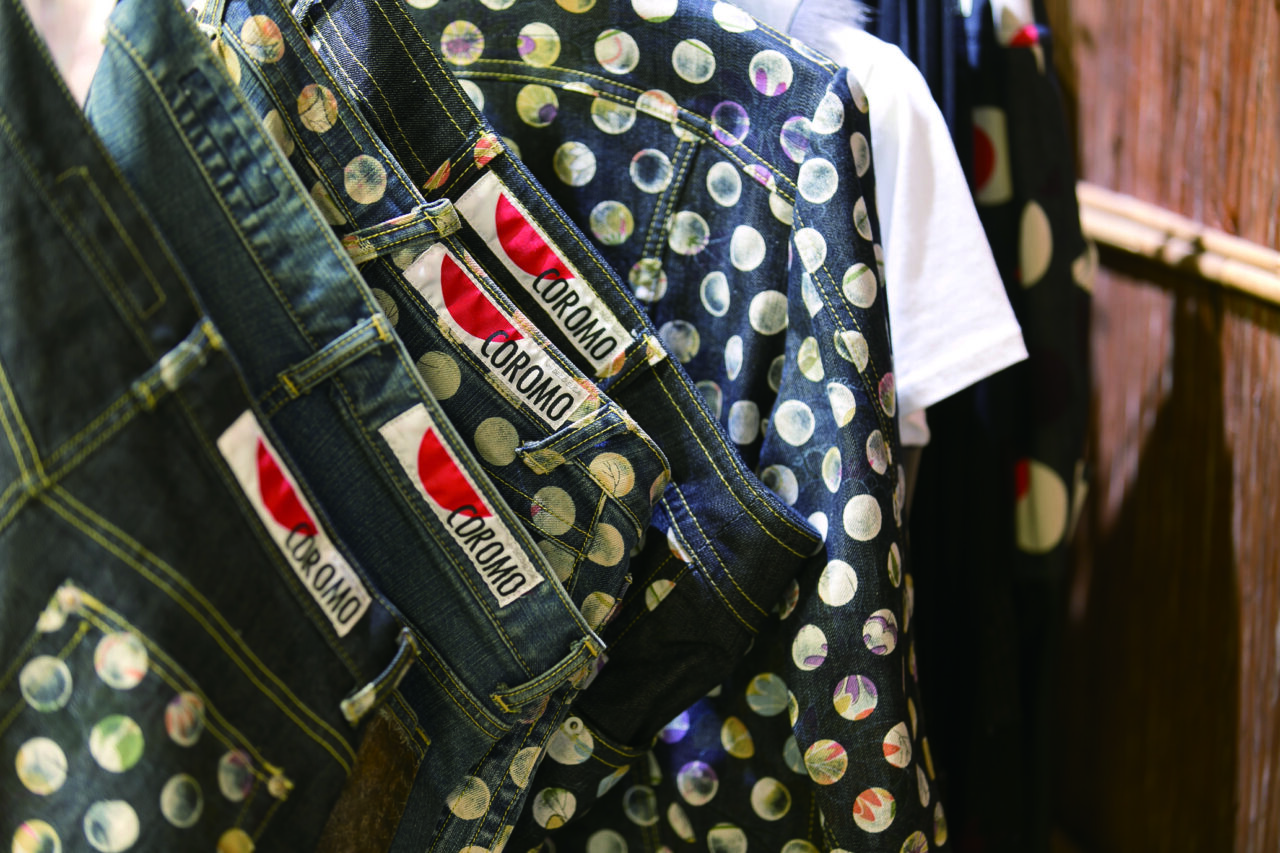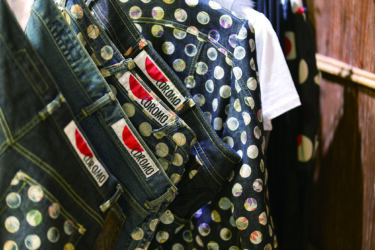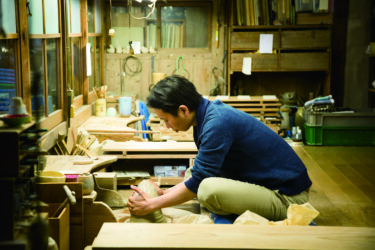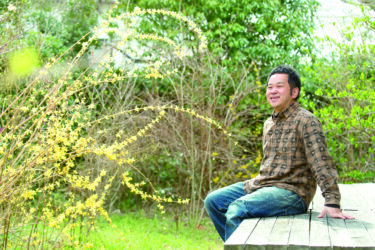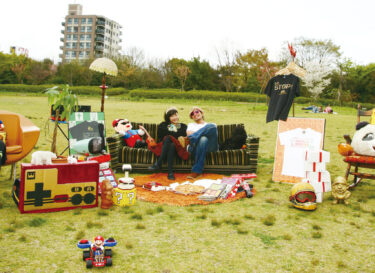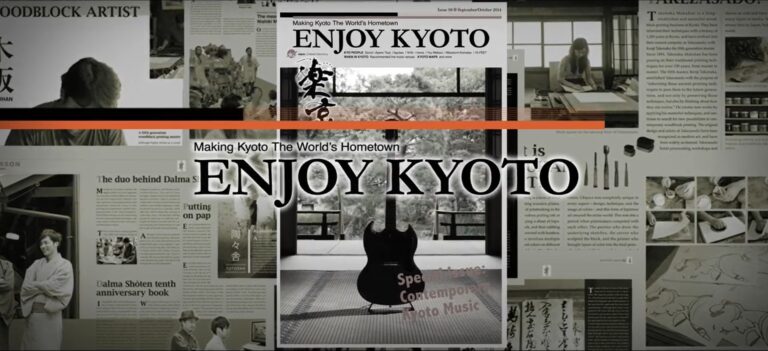- 1 The starting point: Designer Hideco Sugai’s philosophy of fashion
- 2 The New York years: Cultural encounters
- 3 Back in Japan: Demanding company work and breaking out alone
- 4 Independence: Dashing along the runway
- 5 To Kyoto: The next step in the home of the kimono industry
- 6 The latest chapter: Bringing street style to the kimono
- 7 Deco Japan
The starting point: Designer Hideco Sugai’s philosophy of fashion
Kyoto-based fashion business Deco Japan was established some thirty years ago by designer Hideco Sugai. Based on the concept “enveloping the mind and the body”, the starting point for Sugai’s clothes might be described as a kind of chemical reaction caused by fusion of extremes. The mind and the body, East and West, high-tech and traditional materials, functionality and playfulness- Sugai’s fashion is steeped in a rich sense of opposition. The designer herself likes to describe it as crossover.
Hideco Sugai was born and raised down the road in Osaka. After studying costume design there, she ventured by herself to New York to study design and marketing at the Fashion Institute of Technology (FIT), the alma mater of countless legends including fashion designers Calvin Klein and Céline Vipiana, as well as Nina Garcia, former fashion director of Elle and Marie Claire magazines. At the same time, she took English classes at the State University of New York. Sugai was 23 years old at the time. This was almost forty years ago, an age when studying abroad was not easy for a Japanese woman. Nonetheless, she was driven by a pure and simple force: the desire to prove herself overseas.
The New York years: Cultural encounters

Living in a dormitory near FIT in New York, Sugai’s days were spent fraternizing with young people from all over the world. After coffee and breakfast in the cafeteria, Sugai would make her way to school on West 27th street near Seventh Avenue. During the day she attended her classes that were, naturally, held in English. At night at the dormitory she did her laundry using something she had never before seen: an automatic washing machine with a dryer. She strolled Fifth Avenue and frequented the boutiques of Greenwich Village. “It was continuous culture shock every day then,” laughs Sugai. However, her bewilderment also brought her great joy, since the chance to experience different cultures outside of Japan was the life she had wished for.
One incident in particular left a lasting impression on Sugai. One day, she had to make a presentation on a given subject at school. Originality was highly valued; ideas that stood out from the others. Sugai found herself questioning her own identity for the first time. She decided to give her talk on fashion theory based in Japanese aesthetics, showing a collage she had made from the cut-up pages of a pop fashion magazine and some Japanese chiyogami (craft paper in colorful patterns) she had had sent from Japan.
Her presentation was much more warmly received than she expected. It was then that she realized that since it was Japanese culture that had made her who she was, it was strange to be talking about rococo or baroque style before addressing her own personal traditions and culture. Of all her experiences in New York, this was the one that brought the greatest shift in values, and was to profoundly influence her style as a designer. After two eventful years she had used to the absolute fullest, and graduating in her own style, Sugai returned to Japan as she had promised her parents she would. Yet as she flew out of JFK International Airport, she whispered a promise to the West. “I’ll be back someday.”
Back in Japan: Demanding company work and breaking out alone
On returning to Japan, Sugai began working as stylist at Teijin Limited, a well-known Japanese company specializing in fibers. She chose the job because she had felt instinctively that textiles were ‘the building blocks of fashion’. There she studied the basics of textiles, and worked in the marketing department, mainly in charge of materials development and exhibition planning. While there were a number of female stylists working at the time, Sugai was the only woman involved in overseas marketing. She was in her element in this position, utilizing her English language skills and overseas experience in dealings with overseas buyers and exhibitions in Europe and other parts of the world.
Her working days spent traveling the globe, Sugai absorbed a wealth of information, including the world-class quality of Japanese synthetic textiles and the technologies behind them, the differences in characteristics between high-tech fibers such as polyester and traditional natural fibers, and the techniques used by fabric artisans in Japan. Eventually a resolve grew within her. She reflects, “There weren’t many fashion designers with such thorough knowledge of both synthetic and natural fibers. I wondered if that was the key to making clothes that only I was capable of.” Sugai felt the time had come to branch out on her own.
Independence: Dashing along the runway
In 1980 Sugai set up an office in Osaka, and Deco Japan Co. Ltd. was born. She was about 30 years old at the time. Although she had been brilliant in her work with Teijin, her lack of connections (aside from her apparel-store-owning father and fashion designer mother) and track record in the apparel business presented a considerable challenge. However, fate was on her side. Around this time the City of Osaka was establishing an event with the aim of nurturing fashion designers, the Osaka Collection. Sugai was invited to participate, and quickly accepted. Fellow participants included Osaka-born Hiroko Koshino who was already active in Europe. The stage was set for Sugai to strut her stuff.
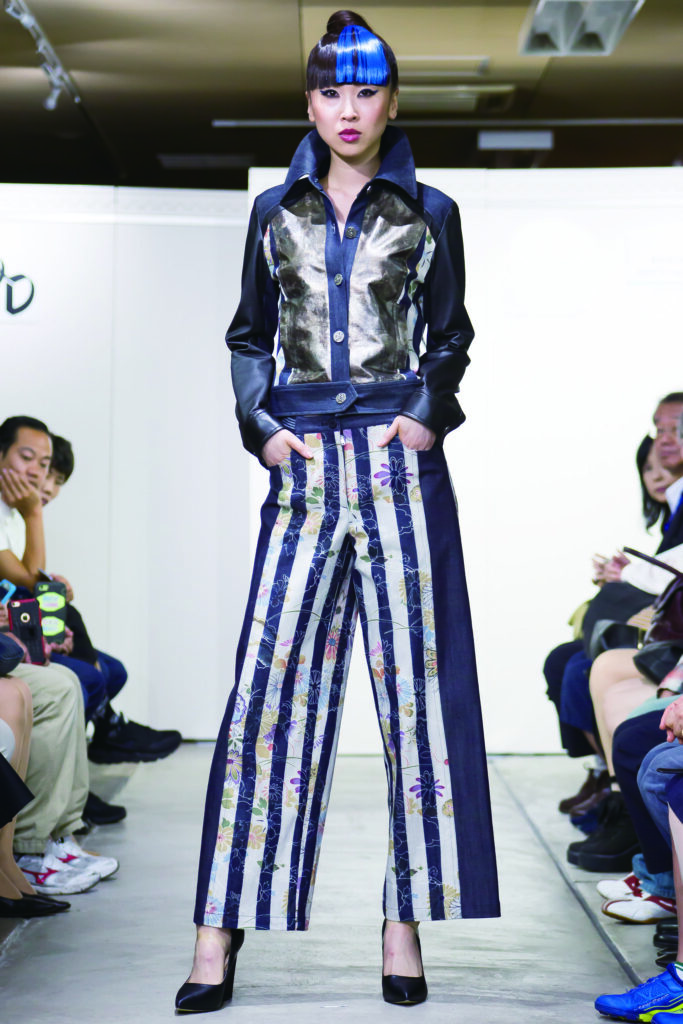
For her first item, Sugai created an original arabesque jacket using Kyoto’s Nishijin-ori fabric. With this piece, Sugai’s concept- ‘making fashion out of kimono fabric’, and on top of that, using the techniques and sensitivity of traditional kimono trades to create modern fashion- was made reality. Those emotions she had felt when questioning her identity in New York were infused in the garment that made up her first steps as a fashion designer. It was her first “crossover”. Here Sugai examined her starting point once more. She tells us, “Of course, the traditional culture that is the kimono is a kind of fashion that Japan is proud of. But on the other hand, the first-rate fibers that have supported Japan since the war are another facet of Japan, and Teijin is at the top of that field. I thought that, with my knowledge of both aspects, my personal contribution to society was to offer this crossover”.
Since these first steps, Sugai has been remarkably successful, starting with her Tokyo Collection debut in 1990, as well as uniform designs (including those of the Hotel Granvia Kyoto), a design contract with Adidas, and exhibiting at fashion galleries such as Paris’ Espace Carole de Bona and Atmosphere. Her career as an international designer was assured. However, Sugai is not one to be satisfied by this. She was already making her next step.

COROMO by deco sugai
The Coromo by deco sugai line is known for its creative use of textiles and expressive silhouettes. Sugai’s first work in polyester, the arabesque Nishijin-ori jacket features a striking collar that makes brilliant use of the material’s smooth texture. Designer Hideco Sugai is synonymous with this original line of denim fabric creations decorated with dying techniques used in kimono making, such as yuzen dying and batik.

ASAGI BROCADE by deco sugai
Created in collaboration with Kyoto kimono maker Tsukaki Shoji, Co. Ltd., this piece is made using Kyoto’s own Nishijin-ori Asagi, the world’s finest weaving technique.
Nishijin-ori Asagi fabric painstakingly woven on an 1800-hook jacquard loom is incorporated into Western styling to craft these lavish dresses.
The garment features designs taken from classic works by two Kyoto-born artists; the flowing water design from Red and White Plum Blossoms by Rimpa school artist Ogata Kōrin, who took the art world by storm some 400 years ago, and Itō Jakuchū’s magnificent Plum Blossoms and Moon. This truly is wearable art at its finest.
To Kyoto: The next step in the home of the kimono industry
As Sugai steadily built her career as a designer, she continued to deepen connections with artisans from textile-producing areas around Japan and in the traditional industries centered in Kyoto, searching for mediums through which she could realize her idealistic styles, and ultimate forms of fashion crossover. One of her biggest projects of the time was a five-year development of kyo-yuzen denim. She recreated on computer yuzen dyeing designs from the early 20th century Taisho Era, and pioneered a process through which denim was created using the tenasen technique, at a single Kyoto workshop. The ‘crossover denim’ creations born out of this unique process became part of Sugai’s collection, and she hopes to use these techniques to create a casual line of kimonos in the future.
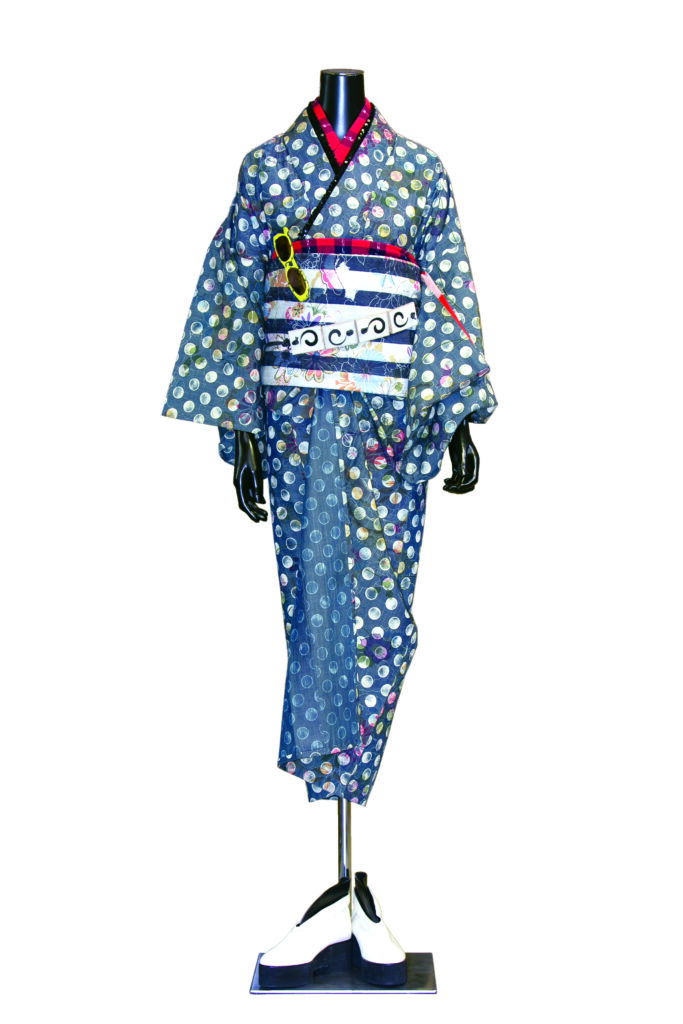
Based on the success of projects such as this, Sugai decided that Kyoto was the perfect place from which to base her creative endeavors. In 2006 she moved her operations to Kyoto from her hometown Osaka, and in April the year before last, she opened her long-awaited concept shop that serves as her studio, office and gallery. This fashion hub is the fruit of her many years of activity.
Sugai’s concept shop is located in central Kyoto on a narrow street near the large intersection of Karasuma-dori and Oike-dori, in a corner of an area lined with office buildings. The shop is a renovated Kyoto-style machiya townhouse, which typical of housing in Kyoto, is long and narrow, stretching back 30 meters from the street. Just inside the entrance is the shop space where Sugai’s designs are displayed. Behind the shop space is the office and the studio, enabling a continuous flow from the initial conception through to sales point. Sugai’s shop is also used as an event space for fashion shows and live performances. In October last year the space hosted a showing of Sugai’s original collection with a live shakuhachi and shamisen performance, held as part of Nuit Blanche Kyoto 2015, a cultural event that took place simultaneously in Kyoto and Paris. Doubling as a first anniversary party for the concept shop, the event boasted an impressive turnout, including many guests from the media and Kyoto’s fashion industry.
The latest chapter: Bringing street style to the kimono

What exactly is the difference between kimonos and Western-style clothing? The answer is clear to Sugai. “Western clothes are made to conform to the body, and the wearer is fitted into the clothes. They’re three-dimensional. In contrast, Japanese kimonos are flat. It’s like winding fabric around the body. Similar to origami or chiyogami, you just wrap, fold and tie the fabric. It’s simple, and there’s actually quite a lot of freedom.” It’s similar to the ways in which Western paintings use perspective to create three-dimensionality, whereas Japanese ukiyoe are flat. “It’s an philosophy of Zen- the appreciation of empty spaces and silence- that is the essence of Japanese design,” says Sugai.
“However”, Sugai adds, “I don’t think of Western clothes and kimono as separate things.” This year Sugai is injecting her effort into an even newer form of fashion. While she has taken the approach of using Nishinjin-ori and other kimono production techniques in Western-style fashion in the past, this time her concept is the opposite; she’s challenging herself to use Western fabrics in kimono-like styling.
This kind of tailoring ticks the boxes of informality with ease. The kimonos are shorter in length than regular kimonos, have ceramic accessory-style sash fasteners, and are adorned with sequins. It wouldn’t be an overstatement to call this “kimono street fashion”. Wear them over a t-shirt or show your relaxed side by pairing them with sneakers instead of the traditional geta sandals. These garments allow the wearer to enjoy a kimono style to be with ease.
Sugai says “A traditional, orthodox kimono looks best when worn correctly and tightly. But at the moment there are no choices for young people or people from other countries who want to wear a kimono with a bit of freedom. Western clothes and traditional kimonos are the only two choices. That’s why I think there should be some kind of middle ground, if you like- a kimono that’s meant to be worn more casually and freely.”
That’s’ the idea behind her latest creation, Haoru an item that can be worn over kimono or Western style clothing equally stylishly. Sugai sees these as simply more “crossovers”. “Wearing something that didn’t exist until that point creates a new mood. I’d like to blow a fresh breeze of change through society in this way. And I hope that breeze is strong enough to reach other countries.”
Indeed, Sugai has plans to open a store in New York this coming autumn. Despite her considerable experience showing at exhibitions and fashion shows in European cities such as Paris and Milan, setting up in New York is a new project with its own challenges. Her new style of kimono will undoubtedly be part of her debut lineup in the starting point for her study of fashion crossovers, New York.
Deco Japan
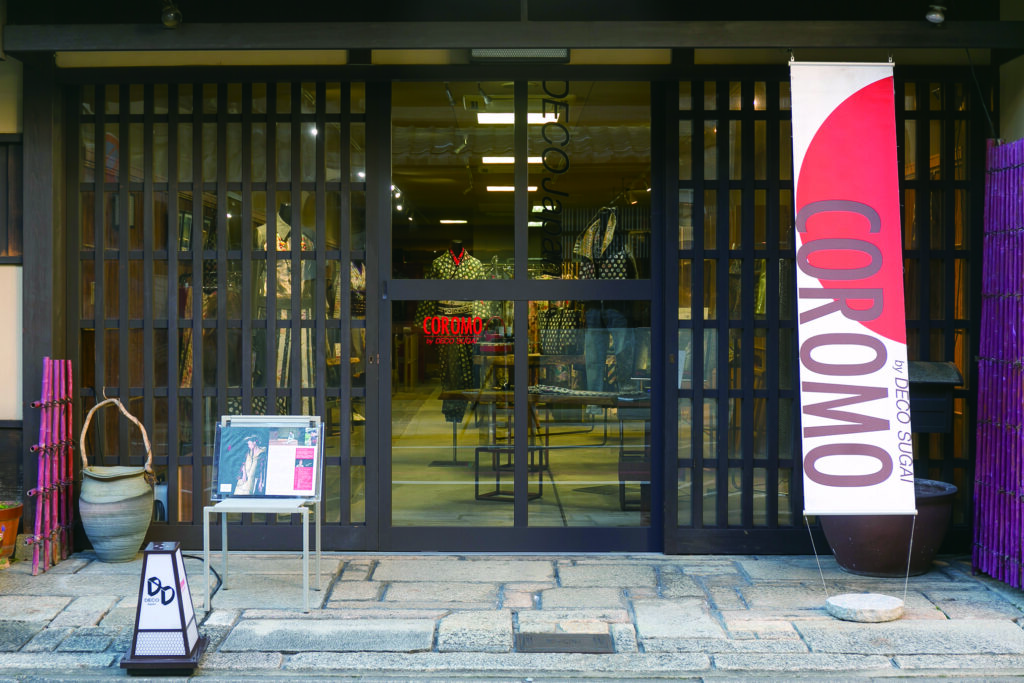
【Address】京都市中京区堺町通御池下ル丸木材木町680-3
【Access】 A five-minute walk from Karasuma-Oike station on the Kyoto City subway (both Tozai and Karasuma lines)
【Open】11:00 am~7:00 pm
【Closed】Sunday, some public holidays
【Credit cards】 Accepted 【Phone】 075-468-8588
【E-mail】deco@deco-japan.co.jp
●Facebook:Deco Japan ●Instagram:@deco_japan
www.deco-japan.co.jp

